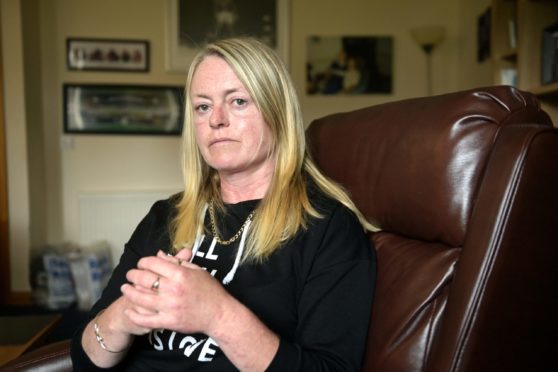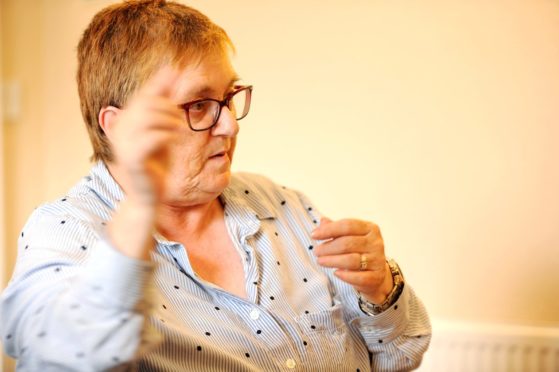A Dingwall mum is pinning her hopes on the arrival of state of the art technology in Dundee which could revolutionise her life.
Donna Kinnear, 49, has suffered from essential tremor in her hands and neck for the past 20 years.
Her doctor said she might have got it anyway later in life, but Donna believes she developed the condition after she was viciously attacked by four young women.
The ordeal is still vivid: “They got me on the communal stairs outside the door, got me on the ground and kicked me in the head.
“Eight feet kicking my head.
“I got through the attack, had two beautiful children, passed my driving test, made a good life and that was my revenge.”
But since then, the tremor has gradually taken over Donna’s existence.
She was put on a full range of medications for it but found none of them worked, or agreed with her.
She went on to have botox injections in her neck, which was badly affected, but this wasn’t successful either.
She said: “I’ve tried acupuncture, hypnotherapy and went through all the tests for deep brain stimulation (DBS) but I was refused it.”
DBS involves a neurostimulator, sometimes called a brain pacemaker, being implanted in the brain to send electrical impulses to specific areas to treat movement disorders such as essential tremor and Parkinson’s.
Donna’s psychiatrist told her the dangers outweighed the benefits in her case, because it risked making the depression caused by her condition worse.
Donna had to leave her job as a care at home worker after 13 years due to anxiety and depression brought about by her condition.
“I had to meet new people all the time and explain my condition all the time and put up with stares.
“The stress and anxiety made my condition worse, and it became a vicious circle.”
Donna found another job, but because she was sedentary, her neck effectively froze from all the trembling.
“The chiropractor said the biggest muscle in my neck had had enough from all the movement after 20 years.
“I’ve only got certain movement on each side.
“The pain is horrendous on a daily basis, even when I’m walking, eating, driving.
“I can’t work.
“I asked to be referred to a movement specialist but was told I can’t be referred outwith my area.”
Now Donna finds herself at a dead end as regards treatment.
She said: “I received an email the other day from my physio who said neuro rehab aren’t taking up my case because they don’t know enough about it, so they then passed it on to neuro surgery, who passed it onto neurology who I’ve already seen and who suggested I take medication, which I’ve already tried.
“Other than that I’m fit and healthy, I do a lot of power walking and I just want to get back to work.”
Through the Scottish Tremor Society, Donna heard that a focused ultrasound machine is coming to Dundee, which might help her condition.
She said: “It’s not available yet, but I would do a trial.”
Meanwhile Dalneigh sufferer Mary Ramsay, chairwoman of the Scottish Tremor Society, has been campaigning for the machine to be made available to essential tremor patients.
It was fund-raised for by Dundee University, world leaders in Parkinson’s research.
The university has confirmed it will be commissioned later in the year, stressing that it will be available by specialist referral only.
It will be the first and only machine of its kind in Scotland.
Mrs Ramsay said: “Dr Peter Bain of the National Tremor Foundation got a machine and installed it in London and has been doing research on it and they are now at the point where they can get patients treated on the NHS.”
Mrs Ramsay, 65, was born with Essential Tremor, but didn’t get a diagnosis until she was 48.
She said: “I was basically told, it’s just a tremor, you’ll grow out of it, and dismissed.
“It’s in my hands, voice and legs.
“It’s like a jelly on top of a washing machine in full spin.”
She underwent DBS surgery in Dundee in 2004 and now hardly notices the tremor in her hands.
“It’s still in my voice, but has calmed it down a lot and I’ve learned to live with it over the years.
“But not everyone is mad enough like me to go for major brain surgery, that’s why I’m been campaigning for sufferers to get access to the Dundee machine.”
What is Essential Tremor?
It’s described as a neurological condition is usually caused by faulty circuits in the thalamus, a small area at the base of the brain.
Everyone trembles, but usually the movements are so small it’s not noticeable.
When it becomes noticeable enough to go to the doctor, it’s classed as ‘essential tremor’.
It’s most common among people over 65, but it can affect people at any age.
Around 1m people are affected in the UK, 250,000 seriously.
Multiple millions are affected around the world, with 10m in the US alone.
No-one knows what causes it, and its’s quite often hereditary.
The National Tremor Foundation describes it as one of the most common neurological movement disorders, estimated to be eight to 10 times more prevalent than Parkinson’s disease.
“People exhibit a rhythmic trembling of the hands, head, legs, trunk and/or voice.
“It can afflict persons of any age, gender and race and in the vast majority of all cases it is inherited. While more commonly noticed in older individuals, essential tremor can begin as early as birth.”
It can sometimes be treated with drugs, which can have serious side effects, or with Deep Brain Stimulation, but this carries the risk of stroke and infection.
What is MRI guided focused ultrasound?
Or to give it its full name ‘transcranial magnetic resonance guided focused ultrasound thalamotomy’.
This procedure uses focused ultrasound waves generated externally to the body that are directed to, and alter the function of the thalamus to improve tremor.
It’s done under magnetic resonance imaging (MRI) guidance.
Unlike deep brain stimulation, the procedure is non-invasive and doesn’t require the introduction of hardware into the brain, avoiding the maintenance like battery replacement and minimising the risk of bleeding within the skull, stroke and infection.
It can be done as a day-case procedure, and for many patients could be successful as a one-off treatment.

